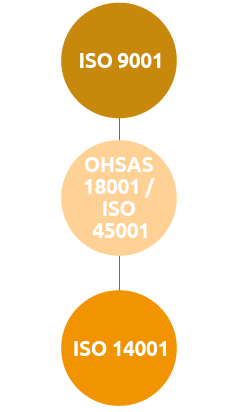The path to become a Snam partner
The qualification to choose the best
International Standards
applied to the most critical
product categories

In managing its supply chain, Snam aims to establish long-lasting relationships, based on sustainable growth and on spreading respect for environmental, social and economic components. To this end, it is therefore essential to act upstream of the management of the qualification process, dedicating from the outset great attention to assessing the suitability of aspiring suppliers and their selection.
The qualification process aims to verify not only the supplier’s current capabilities but also its future potential, according to criteria of objectivity, transparency and traceability. Many elements are analysed: technical and management skills, economic and financial reliability, ethical and reputational risk, commitment to anti-corruption, environmental protection, promotion working conditions that respect healthy and safe requirements, the absence of forced labour and exploitation of minors. There are further requirements for more critical works categories such as the possession of some certified management systems in accordance with international standards. In order to ensure that the list of approved suppliers is adequate to meet current and future procurement requirements, Snam constantly conducts market intelligence analyses and scouts for new suppliers: This ensures the right balance of the number of supply companies on the vendor list, according to criteria that follow the changing needs for the acquisition of goods, works and services over time.
In 2020, a rationalisation of the number of suppliers on the Vendor List (-12% compared to 2019) and of the relevant Product Groups (approximately -7% compared to 2019) was carried out, seeking new and efficient synergies between the suppliers already available. At the same time, the number of suppliers operating in energy transition and new business activities was increased, as well as suppliers operating in sectors functional to pandemic management.
The qualification process resulted in contacting more than 700 companies, covering more than 250 different product areas, and initiating the accreditation/qualification of more than 1,000 new applications. The number of spontaneous applications received from potential suppliers was 1,007 (+2.7%).
| Download XLS (11 kB) |
|
2018 |
2019 |
2020 |
|---|---|---|---|
Total qualified suppliers |
1,465 |
2,085 |
1,855 |
of which in more important and strategic product categories (categories A and B) |
258 |
227 |
221 |
Total number of suppliers involved in qualification renewal and newly qualified |
611 |
722 |
645 |
Total active goods groups |
571 |
622 |
579 |
of which public |
419 |
402 |
203 |
of which private |
152 |
220 |
376 |
When selecting and qualifying suppliers, Snam, in line with the Social Supply Chain policy published in 2018, promotes the participation of companies belonging to the Third Sector, such as cooperatives, associations and non-profit businesses, providing incentives for its suppliers to adopt similar behaviour in turn and thus generate a multiplier effect. The Group’s goal is to increase the number of suppliers from the Third Sector on the Vendor List by 20% by 2023 (compared to 2019). More generally, in 2020, there were 26 companies belonging to the Third Sector registered in the Snam Supplier Register, a significant increase in number compared to the 7 companies of the previous year. They provided services for more than Euro 200,000, mainly in the areas of green care and maintenance and catering.
Monitoring performance: pursuing improvement
In order to enhance collaboration with suppliers and promote their development, Snam constantly dialogues with them, involves them in the achievement of objectives, evaluates their performance over time and repeatedly checks their requirements, seeking to integrate them into the Group’s sustainable business model.
The monitoring of their performance and the related audits, inspection visits and assessment processes are the main instruments designed to protect the integrity of the supply chain sustainability and ensure that the expected standards of quality and efficiency are maintained. During the year, 877 feedbacks were collected, referring to the performance of 166 suppliers (+41% compared to 2019), 371 contracts were analysed and, in line with the promotion of sustainable behaviour along the supply chain, 3,815 checks were also carried out on the contributory regularity of 1,768 suppliers and subcontractors, intercepting irregularities in 2.28% of cases (+1.3% compared to 2019).
To evaluate performance over time, Snam also uses a rating index (IR) which takes into consideration the compliance with technical contractual requirements (Quality), the health-safety-environment (HSE) requirements, the agreed delivery times (Level of service), the setting up of a good relationship with the customer for the entire duration of the contract (Behaviour). This assessment is periodically sent to suppliers in the form of an analytical judgement, so that a constructive exchange can take place. In 2020, ratings showed an overall improvement, testifying to the effectiveness of the sharing of know-how and best practices carried out by Snam along the entire supply chain.
Snam may restrict, suspend or even revoke the qualification of a supplier that fails to meet the agreed standards. The possible cases could include, for example: the failure to meet technical-organisational requirements, negative performance evaluation for it or its subcontractors and a non-compliance with the provisions about social security contribution regularity and with the rules laid out in the Snam Code of Ethics. During 2020, 13 measures were adopted within this scope.
| Download XLS (11 kB) |
|
Peso |
|---|---|
Behaviour |
20% |
Punctuality |
10% |
Health, Safety, Environment |
30% |
Quality |
40% |
| Download XLS (11 kB) |
|
2018 |
2019 |
2020 |
|---|---|---|---|
Excellent |
36% |
40% |
34% |
Good |
34% |
31% |
35% |
Adequate |
17% |
18% |
23% |
Insufficient |
6% |
5% |
4% |
Poor |
7% |
6% |
4% |